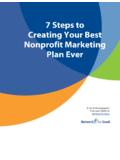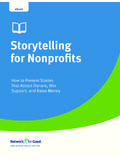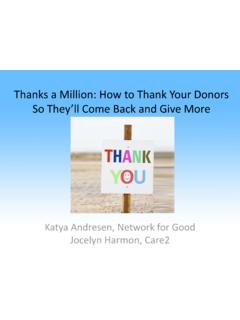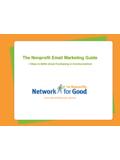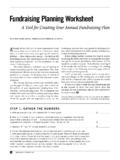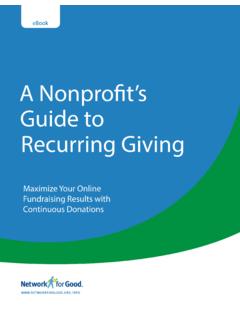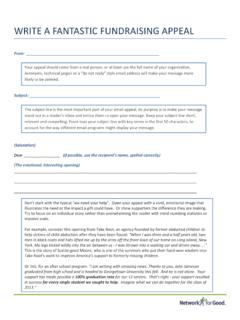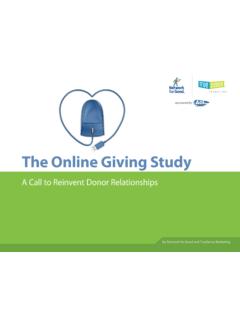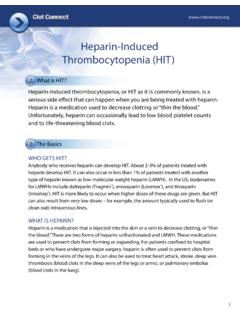Transcription of Fundraising Campaign in a Box - Network for Good
1 (ONLINE) Fundraising Campaign IN A BOX A Planning Resource from Network for Good & Firefly Partners 2009 by Network for Good & Firefly Partners Copyright holder is licensing this under the Creative Commons License, Attribution Please feel free to post this on your website or email it to whomever you believe would benefit from reading it. Thank you! (ONLINE) Fundraising Campaign IN A BOX What s in the box? Does the box have cookies in it? Here are a few A s to your Q s regarding Network for Good s Campaign planning tool: What is this guide all about? In addition to your ongoing Fundraising , advocacy and communication activities, there are times throughout the year when you need to lead your members through a series of actions. Whether it s communication-list building, hitting a Fundraising target to support a new program or structure, or gathering support for a community initiative (to name a few possibilities), you ll get the most bang for your buck by conducting a Campaign .
2 Rocky economic times require all of us to stretch our resources as far as they can go efficiency and effectiveness are the rock stars here and online tools will allow you to do outreach, tracking, follow-up and other activities necessary to reach your goals..And what do you mean by Campaign ? When you Google define: Campaign , you will get no fewer than 40 unique definitions. For the purposes of this planning resource: A Campaign is a series of operations undertaken to achieve a set goal(s), and it operates within a particular time period with defined start and end dates. Essentially: It s a set of actions you need people (including yourself and your team) to take in order to reach a goal or goals. What should I do before I dive into this planning tool? Determine whether your Campaign fits the criteria above. If your message is We need money - you ll need to finesse how you ask for those funds. Figure out what type of Campaign you re undertaking: Fundraising , advocacy, policy, issue, education, etc.
3 Do an internal check of what online resources/tools/services you have in place and evaluate which ones to use. Where should I turn for help along the way? The Network for Good Learning Center: Network for Good s Nonprofit 911 Training Series Archives: Network for Good s Tips e-Newsletters sign up here. There are other Campaign -planning tools we recommend; find the list at the end of this document. 2 Step 1: What are you trying to accomplish? Any Campaign worth its salt is about getting results. What results are you and your organization looking to achieve? Fill out this form to kick off the most important portion of the planning phase determining your audience(s) in order of greatest priority to least*: In each section we ll kick off the planning tool with a couple of examples from our favorite fictitious nonprofit Paws for the Cause as they plan an online Fundraising Campaign to fund the construction of a new pet shelter.
4 Are you thinking, Hey, wait: We re trying to reach the general public, or, Isn t there just one big pool of donors/ If so, let s rewind and flesh out the best practice thinking around this common situation: There is no such thing as the general public. How this phrase ever entered our vernacular we may never know. People come in all shapes and sizes, likes and dislikes, passions and pursuits. Even saying potential donors can get you into trouble how do you target such a vague cloud of people? Segmentation is the key to engagement. Campaign communications are vehicles you should be using to talk about the impact of your work - not about yourself! Become donor/advocate/supporter/subscriber-cent ric by setting your Campaign up for targeted and effective messages. Some audiences are more important than others within the context of your Campaign ! Do you need legislators to take action? Do you need your current supporters to mobilize and become fundraisers for you?
5 Think about your goals and who holds the key to your success. Lack of participation from primary groups can cause your Campaign to falter or fail. 3 1. Campaign Accomplishments AUDIENCE ACTION(S) DESIRED Current Donors Set up recurring donations Make a one-time donation designated to the shelter project Forward information to five friends (viral marketing) Animal lovers in local community Give us email addresses + opt in to updates Make a donation by Q3 of the year Help us grow our house file by using Tell A Friend actions * This prioritization is as important as figuring out the audiences themselves. 4 Step 2: How are you going to accomplish these goals? So - you have groups of people and actions you want them to take. How are you going to tell your story in a compelling manner? What themes, messages and ideas are you going to take from your arsenal of content to encourage action? Complete this form to tease out those important Campaign components.
6 2. Campaign Components AUDIENCE ACTION(S) DESIRED OVERARCHING MESSAGE(S) ACTIVITIES Current Donors Set up recurring donations Make a one-time donation designated to the shelter project Forward information to five friends (viral marketing) Help us continue to serve the animals Help save more animals with a new shelter Share our story eSolicit with link to recurring gift form eSolicit with a need statement for support of the new shelter Push TAF in newsletters and donation receipts Animal lovers in local community Give us email addresses + opt in to updates Make a donation by Q3 of the year Learn how you can make a difference in our community Your support can help save more pets Put info in shelter(s) urging visits to site Prominently display newsletter signup on all web pages Insert soft solicitations in all e-publications 5 Step 3: Which communication channels will you use? Here is a great opportunity to evaluate the activities and messages you laid out in the previous section.
7 There are a variety of online and offline channels that you can use to send the right message to the right audiences. Use this checklist to evaluate the effectiveness of each channel, and then elaborate on how you will use them in this Campaign . Don t forget to consider your offline communication channels and tools! You can boost your results by leveraging and coordinating your offline and online efforts. Is your Executive Director speaking at a local event? Include your Campaign in any publicity you are doing around that event. Look for opportunities to cross promote! 3. Online and Offline Communication Channels ONLINE CHANNELS OFFLINE CHANNELS Organization s website Traditional public relations Search marketing paid and organic searches Paid advertising print, outdoor, television, radio, etc. Online public relations syndicated content, podcasting, dot-com outlets, online magazines and blog coverage Direct Mail Paid online advertising banner ads and purchased content in others e-newsletters Events Email marketing Broadcast programming Social networking and community YouTube, Facebook, MySpace, Flickr, Twitter, etc.
8 6 Step 4: What resources do you need? Is email an important part of your plan but you re still communicating with supporters via Outlook (eek!)? Is your website set up to take online donations? Do you have a quick and easy Sign Up for News interface on your website? Use this portion of the planning tool to ensure that you have all of your tools and resources in place to make your job and the jobs of your audience(s) as easy, effective and cost-effective as possible. 4. Online Tools and Resources TOOL SERVICE(S) WE USE Online donation processing Email marketing Organization website Presence on social networks (if applicable) Not properly equipped (yet)? Take a peek at this sample toolbox: Online Donation Processing CUSTOM DONATENOW DonateNow is an online donation processing service for nonprofits to accept credit card gifts on the Web. Customized donation pages that look exactly like your Website Process one-time or recurring donations from supporters On-screen and email receipts, plus instant donation notification A configuration wizard makes setup and upkeep quick & easy Email Marketing EMAILNOW EmailNow (powered by Emma) was built by email marketing experts to do the tough stuff for you.
9 It allows you to send beautiful email appeals without having to become a designer or a software engineer or someone who knows HTML or CAN SPAM laws. Website , , (Visit these website providers websites to learn more about what they can offer nonprofits.) Social Networks CAUSES ON FACEBOOK, MYSPACE Causes provides the tools so that any Facebook user can leverage their Network of real friends to effect positive change. 7 Step 5: Who s in charge here? (Who will execute your Campaign steps?) Accountability will make or break the success of a Campaign . As much fun as it is to pass the buck, now is as good a time as any to decide which members of your organization, board or volunteers are responsible for the different portions of your Campaign . Planning the staffing and responsibilities before you push go will aid in a number of ways: Determine the key movers and shakers of the Campaign . In the course of planning, you may find that the development director is responsible for 90% of the Campaign s activities and tasks.
10 Revisit your list and decide whether to add additional human resources to those activities or take them off that person s plate entirely. Figure out the timeline. We ll dive into this a bit more in Step 7, but keep in mind that staffing decisions may impact the overall timing of your Campaign . As much as we in the nonprofit sector love working extremely long days and weekends (note the return of the facetious tone), there are only so many hours in the day. If one or two people are spearheading all communications, be realistic about how long it will take for copywriting, editing, distribution and follow-up activities. Create transparency into your Campaign . Empower your employees and volunteers to find answers and the people who have those answers quickly. This transparency not only comes in handy when questions arise but when the Campaign is rolling along or near conclusion accountability is king for taking the pulse of your initiative and reporting after it s completed.
